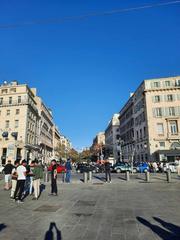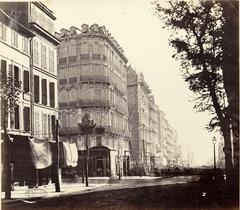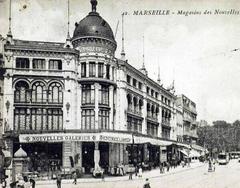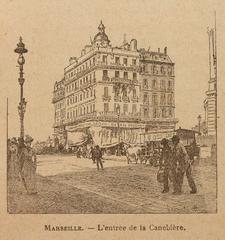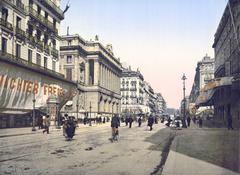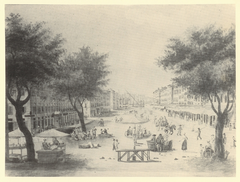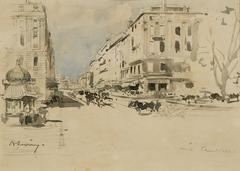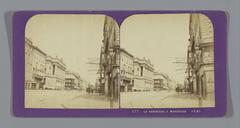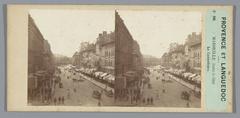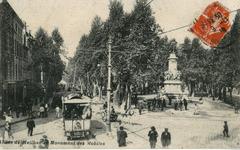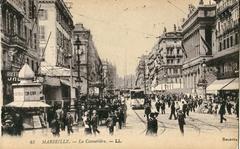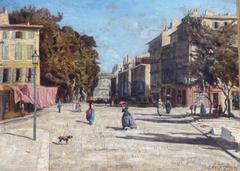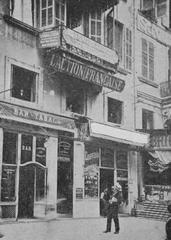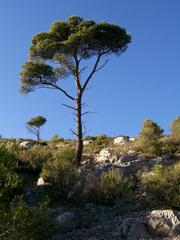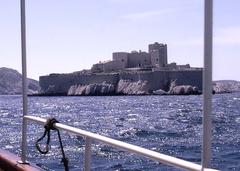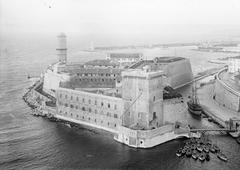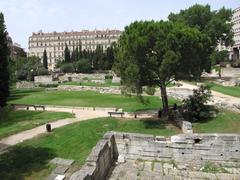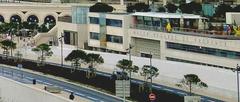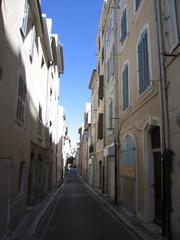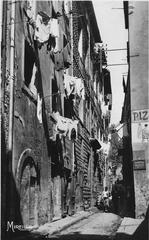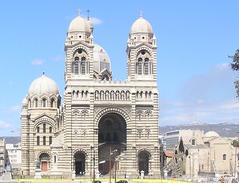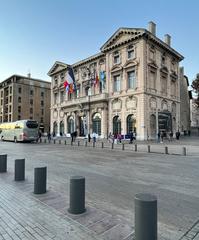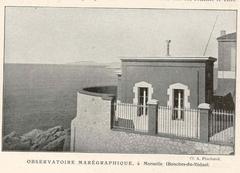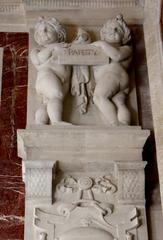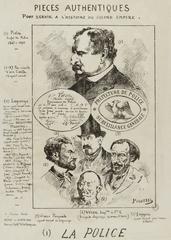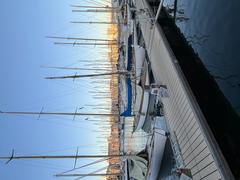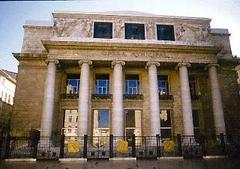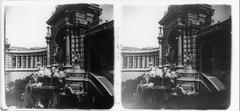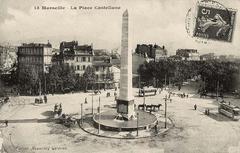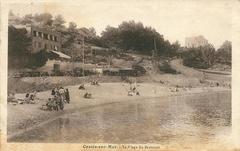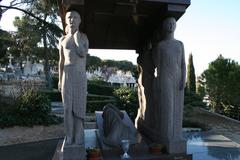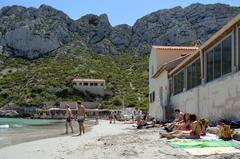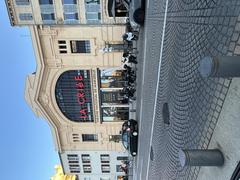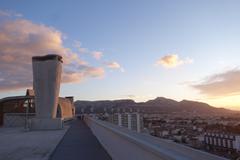
La Canebière: Visiting Hours, Tickets, and the Ultimate Guide to Marseille’s Historic Boulevard
Date: 14/06/2025
Introduction
La Canebière is the vibrant heart of Marseille, a boulevard steeped in centuries of history, commerce, and cultural life. Stretching approximately one kilometer from the Old Port (Vieux-Port) to the neo-Gothic Église des Réformés, this iconic thoroughfare offers an immersive experience of Marseille’s rich maritime legacy and dynamic urban energy. Whether you are drawn by its architecture, festivals, shopping, or simply the pulse of everyday life, La Canebière is a must-see for every visitor to Marseille.
This comprehensive guide details everything you need to know about La Canebière, including visiting hours, ticket information for nearby attractions, accessibility, transport tips, suggested itineraries, and answers to frequently asked questions.
Historical Overview
Origins and Etymology
La Canebière’s name originates from the Provençal word canebiera, derived from the Latin cannabis (hemp), reflecting the area’s historical role as a center for hemp cultivation and trade. This industry was vital for producing rope and rigging for ships, cementing Marseille’s maritime significance from the Middle Ages into the modern era (marseille-tourisme.com; wikipedia.org).
17th–19th Centuries: Growth and Prestige
Commissioned under Louis XIV in 1666, La Canebière began as a modest street linking the Cours Saint-Louis to the Arsenal des Galères, Marseille’s historic shipyard (myguidemarseille.fr). By the 18th century, it had become a lively commercial avenue, home to luxury shops and bustling markets. The closure of the arsenal in 1785 allowed the avenue to extend to the Old Port, integrating it further into city life.
The 19th century ushered in expansion and architectural grandeur, with the construction of iconic hotels and the extension of the boulevard to its current length. La Canebière earned comparisons to the Champs-Élysées, symbolizing Marseille’s cosmopolitan spirit (travelsetu.com).
20th–21st Centuries: Renewal and Modern Identity
La Canebière thrived as a social and cultural hub in the early 20th century, lined with cafés, theaters, and shops. Although the mid-20th century saw periods of decline, recent decades have brought revitalization through restoration projects and enhanced public transport. Today, La Canebière is once again a lively artery, balancing its historical legacy with the rhythm of modern Marseille (marseille-tourisme.com).
Visiting Hours, Tickets, and Accessibility
- Boulevard Access: La Canebière is a public street, open 24 hours a day, seven days a week.
- Shops and Cafés: Generally open from 9:00 AM to 7:00 PM; hours may vary by establishment.
- Ticketed Attractions: Walking the boulevard is free. However, some nearby attractions (such as the Église des Réformés or the Opéra de Marseille) may have specific opening hours and entrance fees.
- Guided Tours: Multiple walking tours are available, focusing on history, architecture, and gastronomy. Tickets can be purchased online or at the Marseille Tourist Office at 11 La Canebière.
- Accessibility: La Canebière is flat and pedestrian-friendly. Public transport, including metro and trams, is accessible to those with reduced mobility (France Unwrapped).
Getting There and Around
- Metro: The closest stations are “Vieux-Port” (Old Port) and “Noailles” (both Line 1). The metro runs from 5 a.m. to 1 a.m.
- Tram: Lines T1 and T2 stop near the boulevard; trams run from 5 a.m. to 12:30 a.m.
- Bus: Numerous lines serve the area, including night routes.
- Ferry Boat: Cross the Old Port for a scenic arrival.
- Walking: The best way to experience La Canebière and its surroundings (Marseille Tourisme).
Key Landmarks and Attractions
- Vieux-Port (Old Port): The historic harbor and vibrant meeting point.
- Hôtel Noailles: A 19th-century hotel embodying Belle Époque elegance.
- Église Saint-Vincent-de-Paul (Les Réformés): A neo-Gothic church marking the eastern end of the boulevard (marseille-tourisme.com).
- Théâtre du Gymnase: Historic theater hosting plays and cultural events.
- Marché des Capucins: A multicultural daily market offering fresh produce, spices, and street food.
- Opéra de Marseille: The city’s grandest theater, built in the 19th century.
Shopping, Dining, and Local Life
- Shops and Markets: Discover Provençal textiles, Marseille soap, and local delicacies. Don’t miss the bustling Noailles market just off the main boulevard (touristsecrets.com).
- Cafés & Brasseries: Enjoy a coffee or pastis at a terrace café, or try local specialties like bouillabaisse and panisse.
- Street Food: Sample North African and Mediterranean fare from neighborhood vendors.
Events and Festivals
- Annual Santon Fair: Christmas market featuring traditional Provençal figurines, held since 1883.
- Marseille Carnival & International Film Festival: Major annual celebrations with parades and performances (touristplatform.com).
- Bal Patriotique: Commemoration of France’s Liberation, held since 2016.
Best Times to Visit
- Spring (April–June): Pleasant temperatures (15–20°C), fewer crowds, and local festivals (TravelSetu).
- Autumn (September–November): Mild weather, vibrant atmosphere, and cultural events.
- Summer: High season, lively but crowded; average highs around 27°C (HikersBay).
- Winter: Quieter and cooler; some attractions may have reduced hours (Lonely Planet).
Safety and Practical Information
- Safety: Exercise standard precautions against pickpocketing, especially in busy areas. Prefer exploring during daylight; avoid less populated areas at night (Offbeat France).
- Tourist Office: Located at 11 La Canebière, open daily 9 a.m.–6 p.m. (closed December 25 and January 1).
- Restrooms: Available at the Old Port and in nearby shopping centers.
- Wi-Fi: Free public Wi-Fi is available in the city center and in many cafés.
- Language and Currency: French is the official language; euros (€) are used. Credit cards are widely accepted.
Accessibility
- Wheelchair-Friendly: Most of La Canebière and public transport is accessible.
- Pedestrianization: Parts of the boulevard are pedestrianized for ease of movement.
- Public Benches and Shaded Areas: Available for rest along the street (France Unwrapped).
Connections to Other Attractions
- Le Panier: Oldest district, known for artisan shops and street art, just a short walk from the Old Port (thecrazytourist.com).
- Noailles: Lively neighborhood famed for its multicultural market and eateries.
- Palais Longchamp: Monumental park and museum complex, accessible via tram or a 20-minute walk.
- Basilique Notre-Dame de la Garde: Iconic hilltop basilica accessible by bus or a scenic walk.
Photographic and Cultural Highlights
- Photo Spots: Panoramic views from the Vieux-Port, ornate facades, and the steps of the Réformés Church.
- Street Art: Discover murals and contemporary public art in adjacent neighborhoods (themarkaz.org).
- People-Watching: Observe Marseille’s diverse population and everyday street life.
Frequently Asked Questions (FAQ)
Q: What are La Canebière’s opening hours?
A: The boulevard is open 24/7. Shops and nearby attractions generally operate from 9 a.m. to 7 p.m.
Q: Are tickets required to visit La Canebière?
A: No tickets are needed to walk the boulevard. Tickets may be required for guided tours or museums.
Q: Is La Canebière accessible for people with disabilities?
A: Yes, it is flat and pedestrian-friendly; public transport is also accessible.
Q: What is the safest way to explore La Canebière?
A: Visit during daylight hours, keep valuables secure, and be aware of your surroundings.
Q: How can I book a guided tour?
A: Tours can be booked online or at the Marseille Tourist Office at 11 La Canebière.
Practical Tips
- Language: Basic French greetings are appreciated.
- Currency: Carry some cash for small purchases; credit cards are widely accepted.
- Dress Comfortably: Wear good walking shoes and dress for the season.
- Keep Valuables Safe: Use anti-theft bags in crowded areas.
- Opening Hours: Typical shop hours are 10 a.m.–7 p.m.; restaurants serve lunch 12–2:30 p.m. and dinner from 7 p.m.
Accommodation
A wide range of hotels, guesthouses, and vacation rentals are available along or near La Canebière. Booking ahead is recommended, especially during festivals and high season (HikersBay).
Sustainable Urban Development
Marseille is committed to sustainable tourism along La Canebière, with initiatives to promote local businesses, eco-friendly mobility, and the preservation of its historic heritage (travelsetu.com).
Call to Action
Ready to explore La Canebière and experience the spirit of Marseille? Download the Audiala app for audio guides, maps, and insider tips. Follow us on social media for the latest updates, exclusive offers, and travel inspiration. Start planning your unforgettable visit today!
Summary
La Canebière encapsulates Marseille’s evolution—from a center of maritime trade and rope-making to the city’s bustling, multicultural urban artery. With 24/7 access, rich architectural heritage, vibrant markets, and a calendar full of events, it offers a glimpse into both the city’s storied past and its lively present. Plan your visit with an eye toward its historic landmarks, accessibility, and special events for a truly memorable Marseille experience (marseille-tourisme.com; travelsetu.com).
References
- Marseille Tourisme – La Canebière
- Canebière (Marseille) – Wikipedia
- La Canebière Main Street Tourism History – TravelSetu
- Canebière: Famous Boulevard of Marseille – TouristPlatform
- 15 Best Things to Do in Marseille, France – The Crazy Tourist
- The Tourist’s Guide to Getting Around Marseille on Public Transport – France Unwrapped
- Is Marseille Safe? Tips and Advice – Offbeat France
- Traveling to Marseille: 20 Things to Know – TouristSecrets
Enjoy your journey through La Canebière, the beating heart of Marseille!
